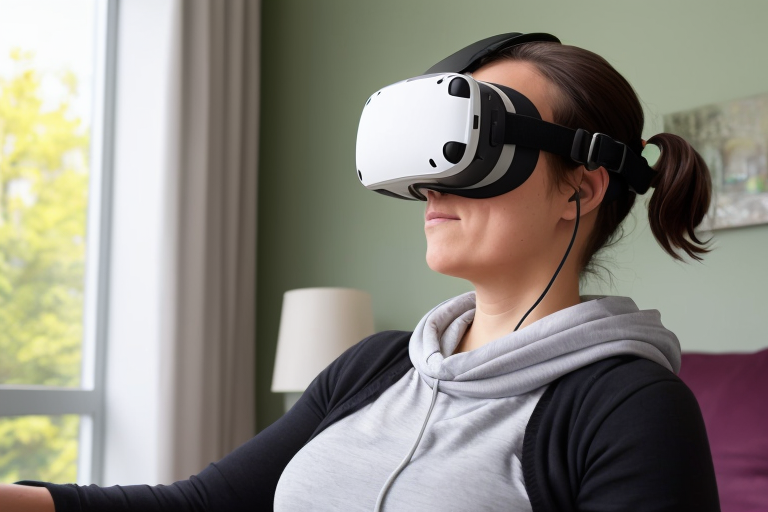Virtual Reality Technology in Mental Health Treatment
Mental health treatment has come a long way in recent years, with advancements in technology providing new and innovative ways to help those struggling with mental health issues. One such technology is virtual reality (VR), which has been increasingly used in mental health treatment to create immersive and interactive experiences for patients. This article will explore the use of VR technology in mental health treatment, including exposure therapy, mindfulness meditation, and cognitive-behavioral therapy. We will examine the potential benefits and limitations of VR-assisted therapy and discuss the future of this technology in mental health treatment.
The goal of this article is to provide an overview of the increasing use of VR technology in mental health treatment and to explore the potential impact this technology could have on the field. We will examine current research and development in VR technology for mental health treatment and discuss possible future applications of this technology, such as remote therapy sessions and personalized treatment plans. By the end of this article, readers will have a better understanding of the potential of VR-assisted therapy to revolutionize mental health treatment and the importance of investing in this area.
Now, let’s dive into the first section of this article, which will explore VR exposure therapy.
Using VR Technology to Overcome Fears and Anxieties
Exposure therapy is a type of cognitive-behavioral therapy that involves gradually exposing a patient to their fears or anxieties in a safe and controlled environment. The goal of exposure therapy is to help patients overcome their fears and anxieties by gradually exposing them to the stimuli that trigger their symptoms. This type of therapy has been proven to be effective in treating a wide range of mental health conditions, including anxiety disorders, post-traumatic stress disorder (PTSD), and obsessive-compulsive disorder (OCD).
However, traditional exposure therapy can be challenging for some patients, as it requires them to face their fears in real-life situations. This is where VR technology comes in. By creating virtual environments that simulate real-life situations, VR exposure therapy provides patients with a safe and controlled environment to face their fears and anxieties.
One example of successful VR exposure therapy is the case of Frankie, a patient who was afraid of flying. With the help of his son, Frankie underwent a VR exposure therapy session where he was able to experience the sensations of flying without leaving the ground. By gradually increasing the intensity of the simulation, Frankie was able to overcome his fear of flying and take a real flight without experiencing any anxiety or panic.
Another example is the case of Uvanni, a therapist who specializes in treating patients with PTSD. Using VR technology, Uvanni was able to create a virtual environment that simulated the experience of being in a combat zone. By exposing his patients to this virtual environment, Uvanni was able to help them overcome their PTSD symptoms and improve their quality of life.
VR exposure therapy has several benefits over traditional exposure therapy. For one, it provides patients with a safe and controlled environment to face their fears and anxieties. This can be especially helpful for patients who are unable or unwilling to face their fears in real-life situations. Additionally, VR exposure therapy can be customized to each patient’s specific needs, allowing for a more personalized treatment approach.
However, there are also some limitations to VR exposure therapy. For one, it requires specialized equipment and trained professionals to administer it. This can make it less accessible to some patients, especially those who live in rural or remote areas. Additionally, some patients may not be comfortable with the use of technology in their therapy sessions.
Overall, VR exposure therapy has the potential to revolutionize the way we treat mental health conditions. By providing patients with a safe and controlled environment to face their fears and anxieties, VR technology can help improve the effectiveness of exposure therapy and provide patients with a more personalized treatment approach.
The Power of Mindfulness Meditation Enhanced by VR Technology
Mindfulness meditation is a technique that involves focusing one’s attention on the present moment, without judgment. It has been shown to have numerous benefits for mental health, including reducing stress, anxiety, and depression. With the help of virtual reality (VR) technology, mindfulness meditation can be made even more engaging and effective.
VR technology allows users to immerse themselves in a virtual environment, which can be designed to promote relaxation and mindfulness. For example, a VR experience might transport the user to a peaceful beach or forest, where they can focus on their breath and let go of their worries. By creating a more immersive and engaging experience, VR can help users achieve a deeper state of relaxation and mindfulness than they might be able to achieve on their own.
One example of VR mindfulness meditation in action is the “Deep VR” program developed by a company called The Virtual Reality Company. This program uses VR technology to guide users through a series of mindfulness exercises, such as breathing techniques and body scans. The program also includes a virtual guide named “Frankie,” who provides encouragement and guidance throughout the experience. Users have reported feeling more relaxed and focused after using the program.
Another example is the “Guided Meditation VR” app, which allows users to choose from a variety of virtual environments, such as a mountain top or a forest glade. Users can then listen to guided meditations that are tailored to their specific needs, such as reducing stress or improving sleep. The app also includes a feature that allows users to track their progress over time, which can be motivating and rewarding.
VR-assisted mindfulness meditation has the potential to be especially beneficial for individuals who have difficulty accessing traditional mindfulness meditation practices. For example, individuals who live in areas without access to mindfulness meditation classes or who have physical disabilities that make it difficult to attend in-person classes may benefit from VR-assisted mindfulness meditation. Additionally, VR technology can provide a more personalized and customizable experience, allowing users to tailor their mindfulness practice to their specific needs and preferences.
While VR-assisted mindfulness meditation shows promise as a tool for mental health treatment, it is important to note that it should not be used as a replacement for traditional therapy or medication. Rather, it should be used as a complementary tool to enhance the effectiveness of other treatments. It is also important to ensure that VR-assisted mindfulness meditation is administered by trained professionals who can monitor and guide the user’s experience.
Overall, VR-assisted mindfulness meditation has the potential to be a powerful tool for promoting mental health and well-being. By creating a more engaging and immersive experience, VR technology can help users achieve a deeper state of relaxation and mindfulness, which can have numerous benefits for mental health. As research in this area continues, it will be exciting to see how VR technology can be further developed and integrated into mental health treatment.
Enhancing Cognitive-Behavioral Therapy with VR Technology
Cognitive-behavioral therapy (CBT) is a type of talk therapy that focuses on identifying and changing negative thought patterns and behaviors. It is a widely used and effective treatment for a range of mental health conditions, including anxiety, depression, and post-traumatic stress disorder. CBT typically involves weekly sessions with a trained therapist, where patients learn coping strategies and practice new ways of thinking and behaving.
While traditional CBT has proven to be effective, it can be challenging for some patients to fully engage in the therapy process. This is where virtual reality (VR) technology comes in. By creating immersive and interactive therapy experiences, VR is enhancing traditional CBT methods and providing patients with more effective treatment options.
One way VR is being used in CBT is by creating virtual environments that simulate real-life situations that trigger anxiety or other negative emotions. For example, a patient with a fear of flying can be exposed to a virtual airplane environment, allowing them to practice coping strategies and gradually desensitize themselves to the fear. This type of exposure therapy has been shown to be more effective than traditional methods, as it allows patients to experience and confront their fears in a controlled and safe environment.
Another way VR is enhancing CBT is by creating interactive tools that help patients practice new coping strategies. For example, a patient with social anxiety can use a VR simulation to practice initiating conversations with strangers or giving a presentation in front of a virtual audience. These simulations provide patients with a safe and controlled environment to practice new behaviors and build confidence.
One example of VR-assisted CBT in action is the use of VR technology to treat veterans with post-traumatic stress disorder (PTSD). The VR simulations allow veterans to relive traumatic events in a controlled environment, allowing them to process and cope with the emotions associated with the trauma. The simulations also provide a safe and controlled environment for veterans to practice coping strategies and gradually desensitize themselves to triggers.
Another example is the use of VR technology to treat patients with obsessive-compulsive disorder (OCD). Patients can use VR simulations to practice exposure and response prevention therapy, which involves gradually exposing themselves to triggers and resisting the urge to perform compulsive behaviors. The simulations provide a safe and controlled environment for patients to practice these techniques and build confidence in their ability to resist compulsions.
Overall, VR technology is enhancing traditional CBT methods and providing patients with more effective treatment options. By creating immersive and interactive therapy experiences, VR is helping patients engage more fully in the therapy process and practice new coping strategies in a safe and controlled environment. As VR technology continues to evolve, it has the potential to revolutionize mental health treatment and provide patients with even more personalized and effective therapy options.
Benefits and Limitations of VR-Assisted Therapy
Virtual reality technology has the potential to revolutionize mental health treatment by providing more immersive, engaging, and accessible therapy experiences. However, like any new technology, VR-assisted therapy also has its limitations and challenges. In this section, we will examine the potential benefits and limitations of using VR technology in mental health treatment.
Benefits of VR-Assisted Therapy
Increased Patient Engagement
One of the main advantages of VR-assisted therapy is its ability to increase patient engagement. Traditional therapy can be challenging for some patients, particularly those with anxiety or trauma-related disorders. VR technology can provide a safe and controlled environment for patients to confront their fears and anxieties, making therapy more engaging and effective.
Accessibility
VR technology can also improve the accessibility of mental health treatment. Patients who live in remote areas or have limited mobility can benefit from VR-assisted therapy, which can be delivered remotely through teletherapy. VR technology can also provide more affordable and convenient therapy options, reducing the financial and logistical barriers to treatment.
Personalized Treatment
VR technology can provide personalized treatment plans tailored to each patient’s unique needs and preferences. Therapists can use VR technology to create customized therapy experiences that target specific symptoms or triggers. This personalized approach can improve the effectiveness of therapy and lead to better treatment outcomes.
Limitations of VR-Assisted Therapy
Need for Trained Professionals
One of the main challenges of VR-assisted therapy is the need for trained professionals to administer it. VR technology is not a replacement for human therapists, and patients still require the guidance and support of a trained mental health professional. The use of VR technology in therapy should be integrated into a broader treatment plan that includes traditional therapy and other evidence-based interventions.
Potential Barriers to Access
While VR technology can improve the accessibility of mental health treatment, it can also create new barriers to access. Patients who are not familiar with technology or who do not have access to the necessary equipment may be unable to benefit from VR-assisted therapy. Additionally, some patients may be uncomfortable with the immersive and realistic nature of VR technology, making it unsuitable for their treatment needs.
Ethical Concerns
The use of VR technology in mental health treatment also raises ethical concerns related to privacy, data security, and informed consent. Patients must be fully informed about the risks and benefits of VR-assisted therapy and provide their consent before participating in treatment. Therapists must also ensure that patient data is kept secure and confidential, and that patients are not exposed to any harmful or distressing experiences during therapy.
Conclusion
VR technology has the potential to transform mental health treatment by providing more engaging, accessible, and personalized therapy experiences. However, the use of VR-assisted therapy also has its limitations and challenges, including the need for trained professionals, potential barriers to access, and ethical concerns. As VR technology continues to evolve, it is essential to balance the potential benefits with the potential risks and ensure that patients receive safe, effective, and evidence-based mental health treatment.









